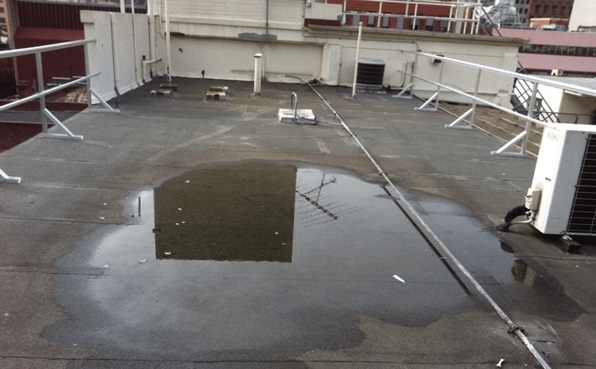Beside the advantages of having a flat roof, there is one major downside. Flat roofing does have a small slope, but this does not allow for proper water drainage as does pitched roofing. Not being able to drain water means there is a risk for pooling, which means that water can collect and puddle.
Pooling water might not be a problem, but if it is allowed to sit over time, the risk of big problems increases. Puddles of water are heavy and can begin to wear away at roofing materials, reducing the roof’s lifespan. A weakened roof system can lead to leaks which can allow water to access the rest of the building.
There are a few tactics that your experienced commercial roofer can employ to take care of pooling water, but it is important to take care of this rather sooner than later.
Flush Existing Drains
Drains collect debris over time and can become clogged, leaving water nowhere to escape. This leads to pools on the roof. To prevent that buildup of debris, make sure you remove sticks, leaves, and all other debris from the roof often. Debris becomes a real nuisance when it collects, so it is best to clean out the drain at least twice a year either yourself or by a professional roofer.
Replace The Membrane
The roof membrane protects your roof from moisture and other elements. Pooling water can damage this membrane, which prevents it from protecting the building. Moisture can build up and seep into the building structure, causing serious structural damage. Pooling water is one of the most common reasons for a damaged membrane.
Most roofing membranes are designed to withstand water ponds, but you need to take care of the membrane for it to do this job properly. Invest in one of the more effective, modern versions and with regular preventative maintenance, your membrane will be stronger and will last. Membrane maintenance includes having a roofing contractor inspect the roof once or twice a year.
Repair Low Spots
Since flat roofing is not entirely flat, there are subtle slopes that develop as part of the installation process. The small slopes are designed to facilitate proper drainage, but weak spots can develop as with all slopes. These are perfect for debris and water to collect. Low spots become an issue and pooling can occur quite easily.
When this happens, the drains can become clogged with debris which forces water to pool at the roof surface. The membrane can become damaged, and leaks can develop. A professional roofing contractor can identify these low areas and take care of them. You can also add more drain lines to the building to help prevent pooling at low spots.
Re-pitch The Rooftop
Pitch that was not properly designed or installed can also lead to pooling water. If there is not enough pitch, water cannot drain as needed, leading to water pooling. Re-pitching can be an expensive investment, but in many cases, it is the only solution. Especially, if you consistently have issues with pooling.
Install Roof Crickets
If you see that water is collecting more easily in certain areas, you may want to use roof crickets. Water often collects easily at vents and chimneys, and roof crickets can help reduce this. Crickets are rigid structures specially designed to divert water around obstructions such as vents and chimneys. When the roof has trouble naturally draining water on its own, roof crickets can help.
Compress Insulation
Another problem that can lead to pooling water is compressed insulation. Compressed insulation is generally caused by heavy roofing equipment and repeated treading over the roof area that can lead to indentations in your roof. These dents are perfect for collecting water, so you need to ensure that the proper precautions are taken with the insulation and during any inspection processes.
Conclusion
One of the most important aspects of building ownership is maintenance. And this includes the roof. Preventative maintenance is the best way to address pooling water and damage, so your roof can continue to work efficiently. Flat roofing is known to develop pooling water easily, so being prepared and maintaining your roof is the only way to prevent it from becoming a serious issue.
For any questions or to schedule a free roof inspection, contact us today!

